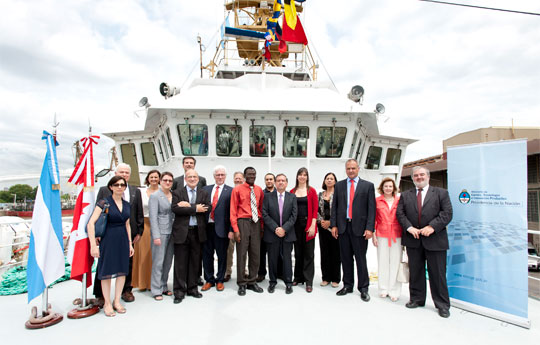INTERNATIONAL COOPERATION
The Coriolis II research vessel will conduct a comprehensive study of the San Jorge Gulf
The campaign will strengthen scientific cooperation between Argentina and Canada.
On January 27th, the Coriolis II vessel is departing towards San Jorge Gulf where the ship will start its first oceanographic campaign. The mission will be carried out jointly between the National Scientific and Technical Research Council (CONICET), the Ministry of Science, Technology and Productive Innovation, the University of Quebec (Canada) and the province of Chubut.
Last Thursday, the official welcoming ceremony for the Coriolis II crew was held. The meeting was attended by the minister of Science, Technology and Productive Innovation, Lino Barañao, the governor of Chubut, Martin Buzzi, the executive coordinator of the Scientific and Technological Ministry, Alejandro Mentaberry, the vicepresident of CONICET in Scientific Issues, Mirtha Flawiá, the Argentina’s ambassador in Canada, Norma Nascimbene de Dumont, and Canada’s embassador in Argentina, Gwynetz Kutz, among other authorities.
The working team comprised of researchers and fellows, both Argentine and Canadian, is led by the Argentine coordinator José Luis Esteves, PhD in Oceanology and CONICET researcher; and Gustavo Ferreyra, PhD in Oceanography, and scientific coordinator for Canada. The research team is going to conduct a comprehensive study of the San Jorge Gulf and they will perform oceanographic, geophysical and geochemistry surveys during the summer of 2014 in the gulf, including the coastline of Chubut.
The oceanographic studies will be conducted on board during the day, and the geology ones at night. Thus the vessel will work 24 hours during the campaign, which will be divided into four stages with a view to allow the participation of most researchers and Argentine students on board.
Some of the aims of the mission are: to survey and research the dynamics of physical, chemical and biological parameters vital for the ecosystem of the San Jorge Gulf from an oceanographic comprehensive perspective; explore the consequences of the spills of hydrocarbons, set up a long term monitoring programme, based on identified measurements from the results of the first two first stages of the investigation. Besides, the campaign also aims for modeling the physical-biological coupling processes within the context of the impacts caused by hydrocarbons and the global warming as well as the effects of the interaction between both factors.
In the San Jorge Gulf the growing maritime transport, together with the current off-shore exploration and exploitation, represents a rise in risks for spills of hydrocarbons. These events warn of the potential risks of oil activity for the marine ecosystem of the gulf and its living resources. For this reason, this novel and comprehensive research is crucial to understand the behaviour of ecosystem and to promote comprehensive exploration of the San Jorge Gulf.
In order to perform this mission, CONICET and the University of Quebec provided human resources to this campaign. Besides, the Ministry of Science, Technology and Productive Innovation together with the National Secretary of Environment and Sustainable Development, and the Ministry of Environment and Control of Sustainable Development of Chubut allocated funds for the costs of the expedition.
